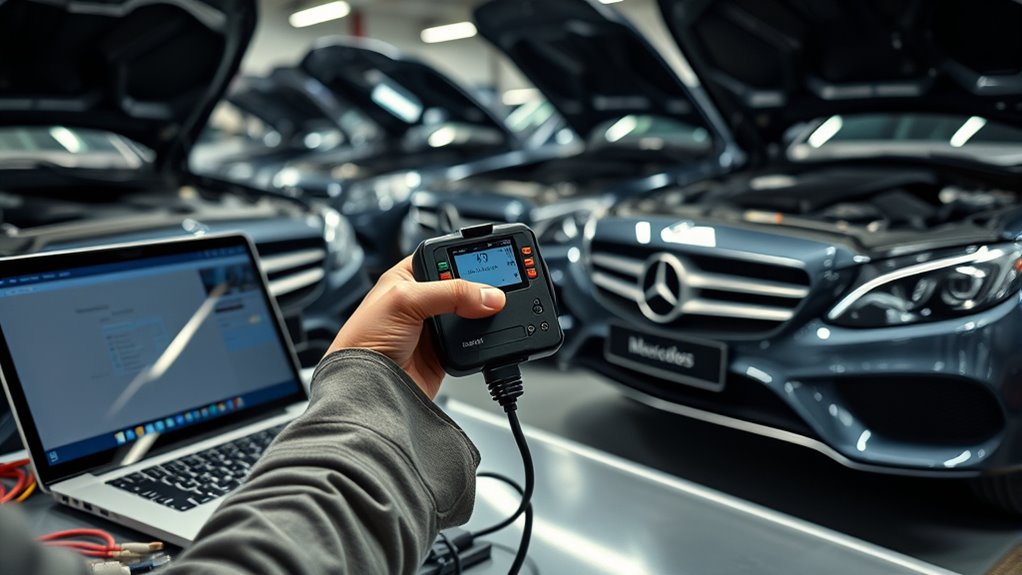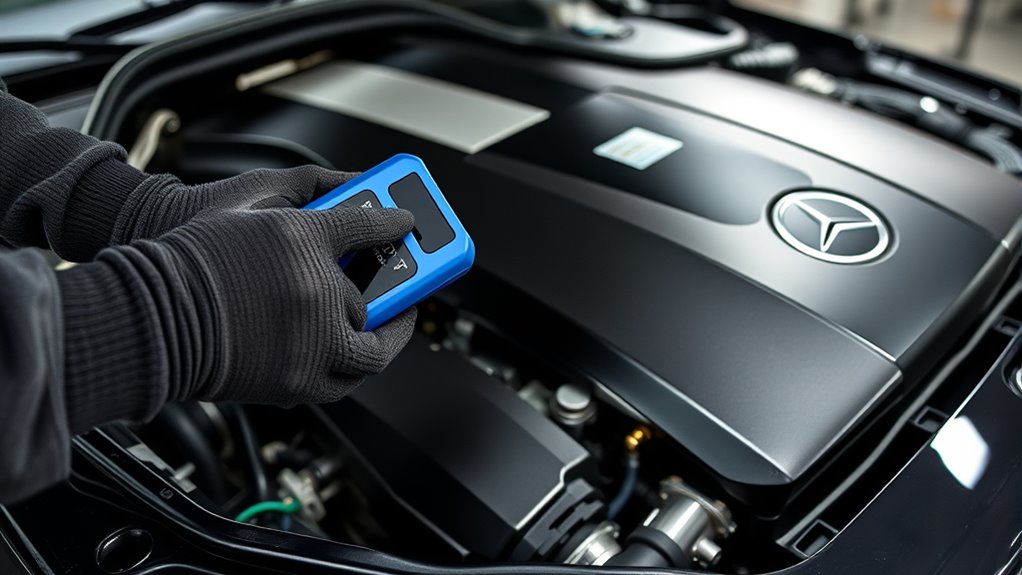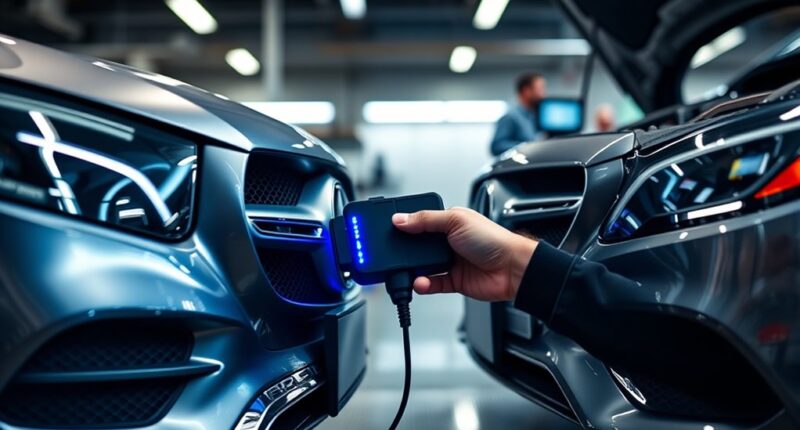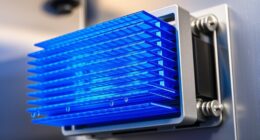ECU flashing for Mercedes GLC and C-Class involves safely locating, removing, and reprogramming the control units using specialized tools like Kess V2 or MPPS V18. You’ll need to back up your data, follow model-specific procedures, and verify compatibility to avoid issues. Proper calibration can boost performance, but risks exist without professional help. Keep reading to discover detailed steps, tools, and safety tips to optimize your vehicle effectively.
Key Takeaways
- ECU location varies; typically under the dashboard or in the engine bay, requiring specific tools for removal and access.
- Use compatible ECU flashers like Kess V2 or MPPS V18, and always back up original files before reprogramming.
- Proper flashing can boost performance by up to 30%, but risks include engine damage, warranty voidance, and legal issues.
- Follow safety protocols such as disconnecting the battery and conducting test drives to ensure fault codes are cleared and performance is optimized.
- Ensure compliance with local laws and manufacturer policies to avoid legal penalties and warranty voidance during ECU tuning.
Understanding the ECU Placement and Removal Process in Mercedes GLC and C-Class

Understanding where the ECU is located and how to remove it is essential before performing any flashing or maintenance on your Mercedes GLC or C-Class. The ECU is usually tucked under the dashboard or in the engine compartment, but its exact position varies by model. For GLC models like the GLC 63, you might need to remove interior panels to access it. In C-Class vehicles, the ECU is often behind trim panels, requiring some disassembly. Placement can differ based on engine size and generation. To remove the ECU safely, you’ll need tools like a socket set, Torx drivers, and trim removal tools. Always disconnect the negative battery terminal first, handle components carefully, and consult your vehicle’s manual for specific instructions. Proper identification and removal are vital for successful flashing. Additionally, understanding the ECU placement can help streamline the removal process and prevent potential damage, especially since ECU location differs across models and years.
Essential Reset Procedures After ECU Flashes

After successfully removing and updating the ECU in your Mercedes GLC or C-Class, performing a reset helps guarantee the new software functions correctly. You can do this by disconnecting the battery or using an OBD-II scanner to clear fault codes and reset adaptive learning data. A full system reset, like disconnecting the negative battery terminal overnight, ensures a clean slate for the ECU to relearn driving patterns. After the reset, start with a test drive to observe improvements in idle stability, shift quality, and overall responsiveness. Use diagnostic tools to verify that fault codes are cleared, and monitor vehicle performance. Remember, resets aren’t a fix for mechanical issues, so ensure all hardware is in good condition before proceeding. This process promotes proper function and smoother operation post-flash, especially when considering ECU tuning to optimize vehicle performance.
Hardware and Software Tools for Safe ECU Reprogramming

When reprogramming your Mercedes GLC or C-Class ECU, selecting the right hardware and software tools is essential to guarantee a safe and successful process. You’ll need specialized ECU flashers like Kess V2 or MPPS V18, which directly write new maps into your vehicle’s ECU. Compatibility is key, so confirm that your tools work with your specific model. Use reliable tuning software such as WinOLS or ECU Editor to modify and create tuning files accurately. Connect everything with proper cables and adapters, inspecting wiring for damage before starting. Always back up your original ECU data before flashing. Additional tools like diagnostic scanners and data loggers help monitor vehicle performance during and after the process, ensuring safety and accuracy throughout your ECU reprogramming. Proper knowledge of Fokos and related tools can further enhance your reprogramming success. Understanding ECU compatibility can prevent potential errors and ensure your modifications are effective. Moreover, staying updated on the latest software versions is crucial for avoiding compatibility issues and improving reflash reliability. Additionally, awareness of financial aspects such as proper budgeting for tools and potential repair costs can contribute to a smoother reprogramming experience. Incorporating testing methodologies into your process can help verify that the ECU functions correctly after reprogramming.
Model-Specific Considerations and Variations

Different Mercedes GLC and C-Class models have unique tuning requirements based on their engine configurations, transmission options, and drive types. For example, the GLC200, GLC43 AMG, and GLC63 each demand tailored tuning strategies to maximize performance without risking reliability. Similarly, C200, C43 AMG, and C63 AMG models have distinct capabilities and limitations. Engine types like inline-4 and V6 influence your approach, while transmission choices—automatic or manual—shape your tuning process. Drive types, whether RWD or AWD, also impact power management and safety measures. Understanding vehicle-specific tuning behaviors and their impact on trust can be crucial when making significant decisions about your vehicle modifications, as emotional detachment from past issues may influence your tuning priorities. Additionally, knowing how vehicle compatibility varies with different setups can help you avoid unintended issues during the tuning process. To optimize your experience, consider the performance adjustments that suit your driving style and vehicle characteristics, ensuring the best balance between power and reliability.
Achieving Performance Gains Through ECU Tuning

Achieving performance gains through ECU tuning involves modifying the engine control unit software to unlock your vehicle’s full potential. With chip tuning, you can see up to a 30% increase in horsepower and torque, making your Mercedes GLC or C-Class more responsive. Tuning stages allow you to select different performance levels for various driving conditions, whether you want more power or better fuel efficiency. Modern digital interfaces, like smartphone apps, make adjusting tuning levels simple and convenient. Professional tuning guarantees modifications stay within safe engine limits, maintaining reliability and engine safety. You’ll notice improved acceleration, better throttle response, and increased torque, which enhances towing capacity and overall driving enjoyment. This process optimizes your vehicle’s performance without compromising its core safety or durability. Understanding the importance of engine safety during tuning ensures your vehicle remains reliable over time. Proper calibration techniques are essential to prevent engine damage and ensure long-term performance. Additionally, utilizing diagnostic tools can help monitor engine parameters and detect potential issues early, safeguarding your engine’s health. Incorporating performance monitoring systems can further assist in maintaining optimal engine operation during and after tuning. Incorporating protective strategies such as cooling system enhancements can also help prevent overheating during high-performance driving.
Risks, Best Practices, and Legal Aspects of ECU Flashing

While ECU flashing can activate significant performance improvements, it also carries inherent risks that you need to understand. Incorrect tuning or pushing your engine too hard can cause serious damage, from engine failure to reduced lifespan of key components. You might also stress your transmission and drivetrain, risking costly repairs. Additionally, flashing your ECU often voids your warranty and can lead to legal issues if it doesn’t comply with emissions laws. To minimize these risks, always work with experienced professionals, use reputable tuning software, and perform thorough vehicle inspections beforehand. Keep records of your modifications and driving habits afterward. Be aware of your local laws and manufacturer policies to avoid potential legal or warranty problems. Taking responsible steps helps protect your vehicle’s health and your peace of mind. Furthermore, understanding engine tuning complexities and the effects of modifications on engine performance can guide you in making informed decisions. Knowing emissions regulations in your area can prevent legal complications related to ECU modifications. It’s also wise to stay informed about regional legal resources and how they may impact your ability to modify your vehicle legally. Being aware of potential legal penalties can help you weigh the risks of illegal modifications against the benefits. Feel the thrill of power, but beware of costly damage. – Risk losing warranty protections and legal peace of mind. – Push your engine’s limits, risking premature failure. – Trust only proven professionals to keep your ride safe.
Frequently Asked Questions
How Do I Identify the Specific ECU Model in My Mercedes GLC or C-Class?
To identify your Mercedes GLC or C-Class ECU, start by locating it in the engine bay or under the passenger dashboard, removing covers if needed. Look for labels with part numbers, serial numbers, or manufacturer codes like Bosch or Denso. You can also connect an OBD-II scanner or specialized diagnostic tool to retrieve ECU info digitally. Checking your vehicle’s documentation or VIN through a dealer or online database can also confirm the exact model.
Can ECU Flashing Void My Vehicle’s Warranty Automatically?
Your warranty isn’t automatically voided just because you flash your ECU, but it’s a serious risk. Manufacturers can void your warranty if they prove the modification caused damage, though they need solid evidence. It’s like walking a tightrope—one wrong move, and your coverage could vanish. Always check your manufacturer’s policy and consider consulting your dealership before making any ECU changes to avoid costly surprises.
What Are the Signs of a Failed ECU Flash or Bricked ECU?
If your ECU flash fails or bricks the ECU, you’ll notice issues like the vehicle not starting, erratic system behavior, or dashboard lights not functioning properly. You might also experience no diagnostic codes, increased engine problems, or poor performance. Communication failures between systems and inconsistent responses are signs. In severe cases, you’ll need professional help or ECU replacement to restore your vehicle’s functionality.
Is It Possible to Revert to the Original ECU Software After Flashing?
Did you know that nearly 30% of ECU reprogramming attempts face issues? Reverting to the original ECU software is often possible if you have the correct backup and compatible tools like Vediamo or MB DAS. You need the original software version and proper diagnostics. But be cautious—improper reversion risks bricking your ECU or voiding warranties. Professional help ensures safe, successful restoration.
Are There Any Regional Legal Restrictions on ECU Tuning Modifications?
You need to know that regional laws can restrict ECU tuning modifications. In some areas, like California, regulations require approvals from agencies like CARB, and non-compliant tunes can fail smog tests or lead to fines. Other states may have fewer restrictions, but it’s crucial to check local laws before modifying your vehicle. Ignoring these rules might result in registration issues, fines, or voided warranties, so always stay compliant.
Conclusion
Think of ECU flashing like tuning a fine instrument—when done right, it reveals your Mercedes’s true potential. But just as a master musician respects their instrument, you must follow proper procedures and precautions. With the right tools, knowledge, and care, you can enhance your GLC or C-Class’s performance safely and legally. Remember, a well-flashed ECU is like a symphony—powerful, smooth, and perfectly in tune.










